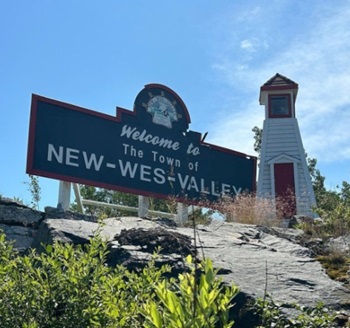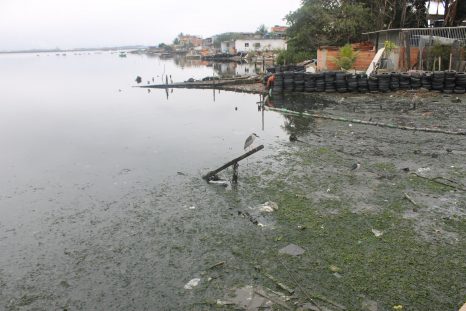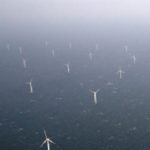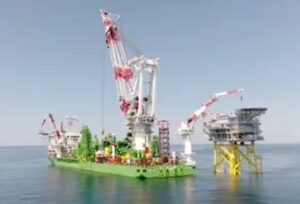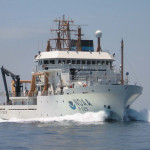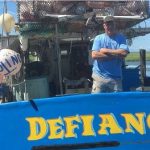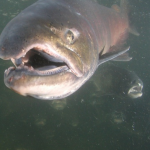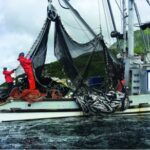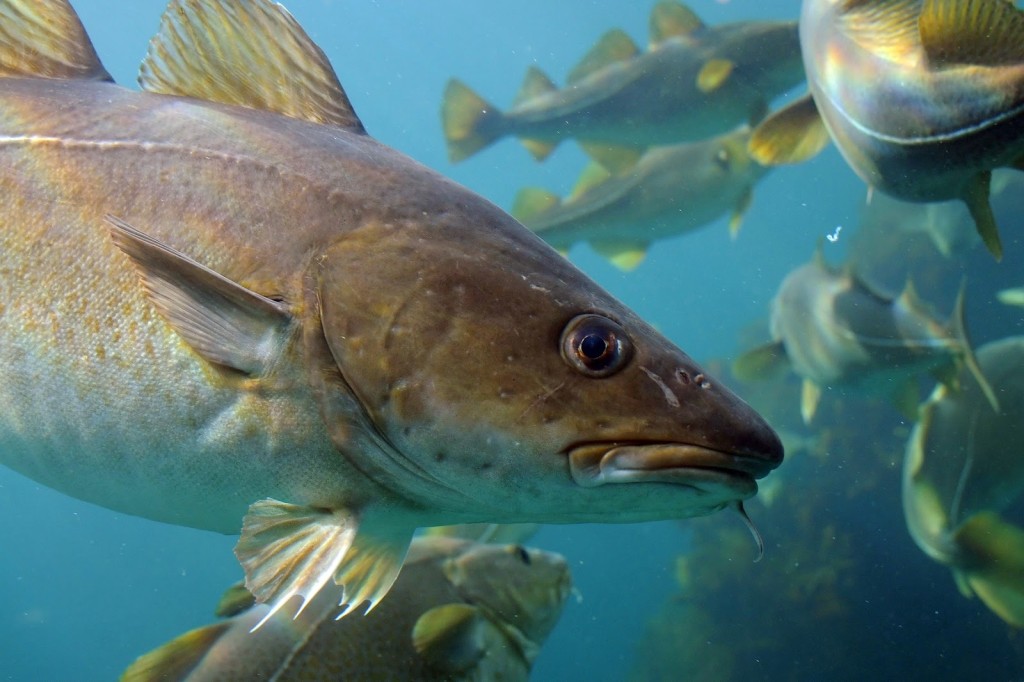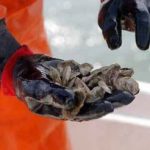Tag Archives: “
FFAW broke collective agreement by telling crab fishermen to keep boats tied up, arbitrator rules
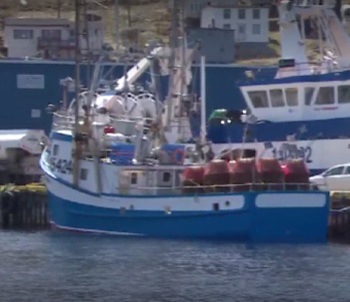 An arbitrator has ruled the Fish, Food & Allied Workers union broke its collective agreement with the Association of Seafood Producers by telling crab harvesters to keep their boats tied up at the start of last season amid a price dispute. In his decision, shared by the producers’ association Tuesday, arbitrator David Orsborn concluded the union declared a “cessation of business dealings,” which violated the terms of the agreement and the Fishing Industry Collective Bargaining Act. The tie-up lasted six weeks, and was fuelled by calls for better prices for harvesters. The price of snow crab was originally set at $2.20 per pound — where it remained when the tie-up ended — but rose to $2.60 per pound by the end of the season. Video, more, >>click to read<< 17:52
An arbitrator has ruled the Fish, Food & Allied Workers union broke its collective agreement with the Association of Seafood Producers by telling crab harvesters to keep their boats tied up at the start of last season amid a price dispute. In his decision, shared by the producers’ association Tuesday, arbitrator David Orsborn concluded the union declared a “cessation of business dealings,” which violated the terms of the agreement and the Fishing Industry Collective Bargaining Act. The tie-up lasted six weeks, and was fuelled by calls for better prices for harvesters. The price of snow crab was originally set at $2.20 per pound — where it remained when the tie-up ended — but rose to $2.60 per pound by the end of the season. Video, more, >>click to read<< 17:52
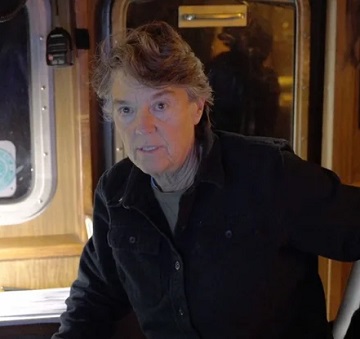
Linda Greenlaw Casts Claim That Deadliest Catch Is More Scripted Than You Think
In Sig Hansen’s estimation, “Deadliest Catch” is not reality television. The veteran skipper regards “Deadliest Catch” as more of a documentary — or perhaps more accurately, a docuseries. Still, “Deadliest Catch” is known to gin up drama. And according to the show’s newest cast member, Linda Greenlaw, “Deadliest Catch” is more scripted than you think. A well-known and highly regarded fisherman, Greenlaw is the sole female swordfishing captain on the East Coast, as well as a noted survivor of the “perfect storm” that plowed through the waters of the Northeast in 1991. Greenlaw is also no stranger to reality TV, having starred in Discovery’s “Swords: Life on the Line,” a series that focuses on the Northeast swordfishing industry. >click to read< 11:07

How Grand Bank made the ‘Grandy dory’ a Newfoundland icon
During the late 1800s and all of the 1900s, the small boat of choice along the south and southwest coasts of Newfoundland and Labrador was the dory.,, Simeon Lowell of Salisbury Point, Mass., is credited with inventing the dory in 1793. Over the ensuing decades these small, shallow draft, flat bottom boats measuring five to seven metres long, became so popular and were in such demand for fishing along the eastern seaboard that eventually “dory factories,” where they were mass-produced, were established. Around the same time schooners from Nova Scotia also took advantage of the lucrative fishing on our offshore banks followed by our own fishermen in 1891, led by Samuel Harris and at least 16 other schooner owners from Grand Bank. photos >click to read< 11:28
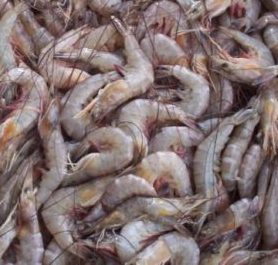
Louisiana sues NMFS over ‘devastating’ rule for its shrimpers
Louisiana has sued the National Marine Fisheries Service in New Orleans federal court to stop it from implementing a regulation that obliges certain shrimp fishermen to install devices that keep endangered sea turtles out of their catch. In a Wednesday complaint, Louisiana Attorney General Jeff Landry said the rule that took effect on Aug. 1, about a week before the beginning of the state’s shrimping season, will have “devastating consequences” on the fishermen’s already thin profit margins, and has sowed confusion with fishermen unable to find enough suppliers of so-called turtle-excluder devices for their fishing nets because the coronavirus pandemic has disrupted the supply chain. >click to read< 19:38
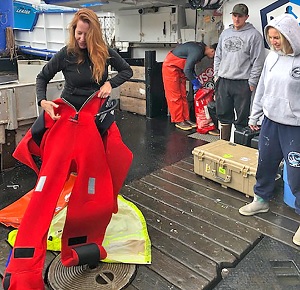
What it’s really like to join the ‘Deadliest Catch’ crew at sea for a day
“Bait!” Capt. Sig Hansen’s voice booms at me from the wheelhouse of his crab fishing boat, the Northwestern,,I’ve joined his five-person crew for a day as the ship’s newbie, or “greenhorn,” to help set gear. It feels just like I’m on the unscripted Discovery hit Deadliest Catch…except I’m not on camera. My assignment: hooking bait bags inside the 875-pound steel-framed crab pots that are dropped one at a time into the churning sea. I climb awkwardly into the 8-foot-tall, 7-foot-wide pot that sits perched on the boat railing, secured by a cable. As I try to attach the bag, my two layers of gloves cause me to fumble, although another reason might be hearing Sig shout, “Turn and burn!” and “Time is money! by Kate Hahn >click to read< 13:51
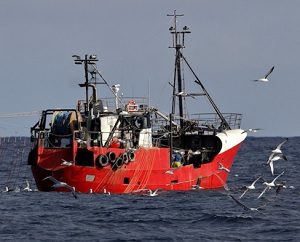
New England Fishing Communities Being Destroyed by ‘Climate Shocks’: Study
The climate crisis is hurting the New England fishing industry, claims a new report published Monday, with a decline of 16% in fishing jobs in the northeastern U.S. region from 1996 to 2017 and more instability ahead. University of Delaware researcher Kimberly Oremus’ paper, “Climate variability reduces employment in New England fisheries,” was published in the Proceedings of the National Academy of Sciences. >click to read< 10:28
New England fishermen losing jobs due to climate: study – While other studies have used temperature projections as a proxy for climate change, Oremus chose the North Atlantic Oscillation, a climate index based on the difference in sea-surface pressure between two points in the Atlantic Ocean—at the Azores and near Iceland. >click to read<

The internet has discovered the “salmon cannon,” and it has become a sensation
“What is a salmon cannon?” I hear you ask. Gather round, children, and I will tell you.,,, A video on Twitter emerged today that shows officials loading large, living fish into an enormous tube to help them bypass a dam that would take days to traverse otherwise. The pipeline allows fish to get from one side of the dam to the other in just a matter of seconds.,,,The dam in question is the Cle Elum Dam, in Washington state. The cannon has allowed Sockeye salmon to go across the dam for the first time in 100 years, Video >click to read< 17:29

Industry challenges DFO’s assessment of Atlantic mackerel stocks
The recent Department of Fisheries and Oceans assessment places the region’s Atlantic mackerel spawning stock biomass in the “critical zone,” meaning it is in decline and must be rebuilt.,,,Scientists say the spawning population is down 86 per cent from pre-2000 levels and the number of fish surviving to breed is at all-time lows.,,,”We’ve had an immense amount of juvenile fish in the population and every year going forward since 2015 we notice more and more juvenile fish prevalent in the catch,” Langille said.,,, He is not alone. The Maritime Fishermen’s Union and fishing interests in Newfoundland and Labrador have also disputed the assessment. >click to read<08:27
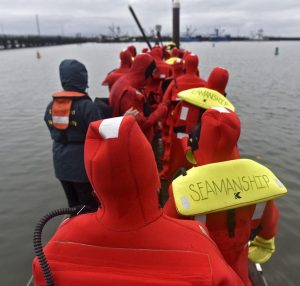
Letter: Celebrate efforts to make commercial fishing safer
I appreciated seeing Colin Murphey’s photography feature showing our local commercial fishing crews engaged in safety training on Nov. 30 (“Fishing — the Most Dangerous Game,” The Daily Astorian) >click to read<. However, the headline struck me as somewhat inappropriate for the content. The Coast Guard holds a drill conductor training here in Astoria three to four times a year, and Oregon Sea Grant helps get fishermen signed up. Amanda Gladics >click to read<08:49

“Fish Farms Out!” – Fish farm opponents detained in protest at Victoria shipyard
Several people were detained at Victoria’s Point Hope Shipyard after illegally boarding a vessel to protest fish farms. Police received reports at around 7 a.m. that protesters had illegally entered the shipyard and boarded a vessel. Calling themselves “wild salmon defenders,” six protesters boarded the Orca Chief, a vessel reportedly used by salmon-farming company Marine Harvest to transport Atlantic salmon to B.C. fish pens. They then unfurled a giant banner that said “Fish Farms Out!” from the bow of the ship. >click to read<15:25
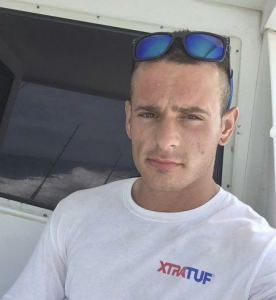
Dixon McGlohon, 27- ‘Wicked Tuna’ Fish buyer city’s 11th overdose of year
Lucas Pina, general manager at the Lynn-based North Atlantic Traders, sent a text message to company buyer and driver Dixon McGlohon of Gloucester on Tuesday afternoon, thanking him for putting so much extra effort into the job. “I just told him, ‘Thanks for stepping up,'” Pina said Thursday, “and he responded, ‘Just doing my job.’ Now that’s class, and that’s the kind of guy he was.” Just a few hours later, McGlohon, known for his appearances on the National Geographic reality TV show “Wicked Tuna,” was pronounced dead at the age of 27, thought by police and Fire Department responders to be Gloucester’s latest victim in the ongoing opioid crisis. Police and the Essex District Attorney’s office are still awaiting a confirmed cause of death from the office of the state medical examiner. >click to read<19:06

One man’s tale of lobstering 50 years in Long Island Sound – and simply loving it
John German hunted the delectable red crustacean for five decades. But as he motored his 40-foot boat, the Suzanne Marie, out of Mount Sinai Harbor at dawn Wednesday, he wasn’t looking for lobster. He was fishing for conch, a spiral-shelled mollusk beloved in Asia. The lobsters are nearly gone — and with them, the $100 million a year that they brought to Long Island. German, 71, is one of the last of the Long Island lobstermen, a group that once numbered as many as 700 but now counts only about a dozen members. The rough ride has been blamed on mostly warming waters and what folks call “the die-off,” the death of millions of lobsters in 1999 that lobstermen attribute to a concentration of mosquito insecticide that made its way into the sea. >click to read<07:04
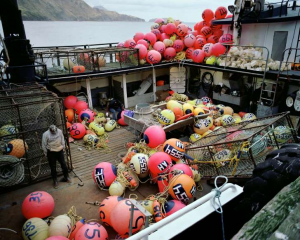
Inside the insane, dangerous lives of Alaskan crab fishermen who work 20-hour days in a ‘constant barrage of storms’
Being a crab fishermen on Alaska’s Bering Sea is a very dangerous job with back-breaking labor and 20-hour work days. In 2002, photographer Corey Arnold decided to give it a try. He ended up doing it for nearly a decade and brought his camera along for the many weeks at sea. The Bering Sea is constantly suffering storms which make the work even more difficult and dangerous. While working long, strenuous hours on the Rollo, Arnold often stole away with the captain’s permission to grab his camera and photograph the crew and the ship. Arnold eventually put together “Fish Work: Bering Sea,” a documentation of his seven adventurous and dicey crab seasons aboard the Rollo. Photo’s >click to read< 13:58
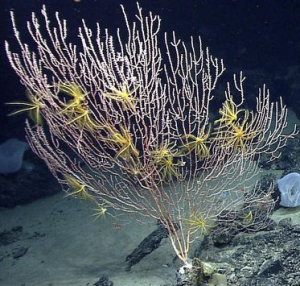
Feds vote to protect more corals in Atlantic Ocean
Federal fishing regulators on Tuesday approved a compromise they said would expand the amount of coral habitat preserved in the Atlantic Ocean while also protecting fishing interests. The New England Fishery Management Council voted on coral protections in an area south of Georges Bank, which is one of the most important commercial fishing areas in the Northeast. The decision came about seven months after the council approved protections in another key New England fishing area, the Gulf of Maine, in June. >click here to read< 17:50 
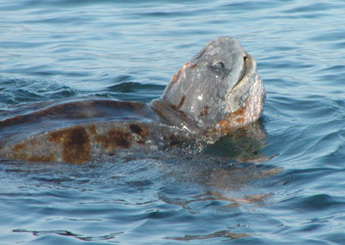
World’s largest sea turtle could come off ‘endangered’ list
An arm of the National Oceanic and Atmospheric Administration has received a petition from a fishing group asking that the Northwest Atlantic Ocean’s leatherback sea turtles be listed as “threatened,” but not endangered, under the Endangered Species Act.,,, NOAA officials have said the agency has reviewed the petition from New Jersey-based Blue Water Fishermen’s Association and found “substantial scientific and commercial information” that the move might be warranted. The agency now has about eight months to make a decision about the status of the turtles. >click here to read< 13:56
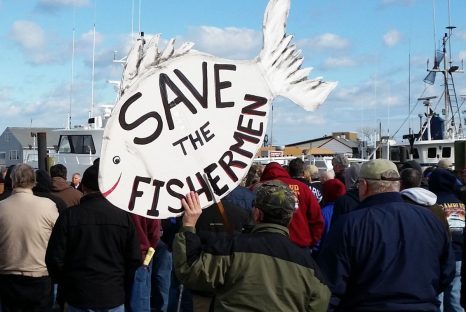
Atlantic States Marine Fisheries Commission rejects NJ’s proposed flounder regulations
The drama surrounding New Jersey’s summer flounder regulations continued Monday, as a regional fisheries management board rejected the state’s adopted regulations for the popular marine catch just days before the fishing season is scheduled to start. The Atlantic States Marine Fisheries Commission, a regional agency that helps set fishing quotas for the 15 East Coast states, found New Jersey’s regulations for the upcoming season were not sufficiently strict to reduce the catches needed to keep the stock healthy and compensate for past years of overfishing. New Jersey’s Marine Fisheries Council adopted those regulations last week, in anticipation that they might be an acceptable compromise. The commission’s rejection means the state is “out of compliance,” a designation that could prompt federal regulators to shut down the entire flounder fishery for recreational and commercial anglers. click here to read the story 15:14
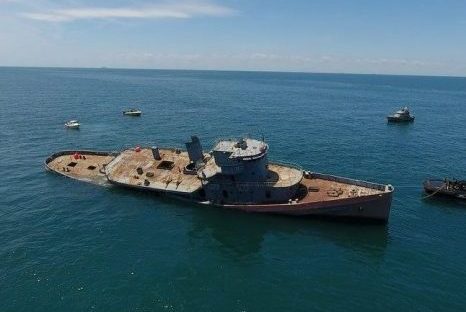
Video: Coast Guard crew says goodbye to the Tamaroa
Forty-four boarded a boat in Cape May early Wednesday morning, including 10 former Coast Guards, to say goodbye to a storied ship with decades of service. The Tamaroa, a 205-foot Coast Guard cutter featured in the “The Perfect Storm,” was scuttled earlier this week 33 miles off of Cape May, becoming part of New Jersey’s artificial reef program. The sinking was delayed numerous times due to rough seas since last October when the state’s Department of Environmental Protection’s had originally planned to sink the ship on the storm’s 25th anniversary. Click here to watch the video, read the story 12:29
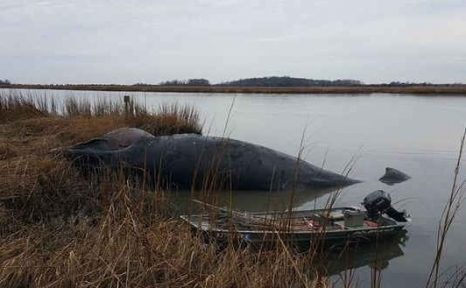
41 humpback whale deaths in Atlantic force fed probe
An unusually high number of dead humpback whales washing ashore along the Atlantic coast has prompted marine mammal experts to open a federal investigation of the cause. But the cause may never be fully determined, according to experts. Since January 2016, 41 of the mammals have washed ashore from North Carolina to Maine. The only cause of death determined so far are cases in which the whales showed signs of being hit by a vessel. But ship strikes only account for a quarter of the deaths. The high number of deaths forced the country’s top marine agency, the National Oceanic and Atmospheric Administration, to declare an “Unusual Mortality Event,” prompting the federal probe. click here to read the story 19:57
East Naples boat captain accused of smuggling immigrants in Florida Keys
 An East Naples charter boat captain arrested Sunday off the Florida Keys faces human smuggling charges. Federal agents said they found 11 people from three Caribbean countries below deck on his boat. None of the 11 were U.S. citizens, agents said. U.S. Customs and Border Protection air and marine officers said they were on patrol in Tavernier Creek about 3 p.m. Sunday when they came across Richard Karl Mork’s disabled boat and two personal watercraft approaching the boat with two gas cans. Officers boarded the boat about 3:30 p.m. and found 11 passengers, including two unaccompanied minors, below deck, according to a criminal complaint filed by the Homeland Security Department in U.S. District Court for the Southern District of Florida. The vessel, named “Scout,” was found about 2 nautical miles from Tavernier, south of Key Largo. Read the story here 21:15
An East Naples charter boat captain arrested Sunday off the Florida Keys faces human smuggling charges. Federal agents said they found 11 people from three Caribbean countries below deck on his boat. None of the 11 were U.S. citizens, agents said. U.S. Customs and Border Protection air and marine officers said they were on patrol in Tavernier Creek about 3 p.m. Sunday when they came across Richard Karl Mork’s disabled boat and two personal watercraft approaching the boat with two gas cans. Officers boarded the boat about 3:30 p.m. and found 11 passengers, including two unaccompanied minors, below deck, according to a criminal complaint filed by the Homeland Security Department in U.S. District Court for the Southern District of Florida. The vessel, named “Scout,” was found about 2 nautical miles from Tavernier, south of Key Largo. Read the story here 21:15
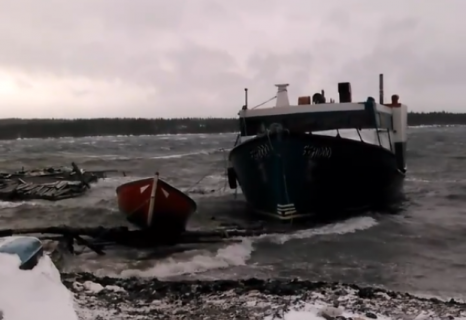
Storm damages fishing boat, raises Holy Hell in western Newfoundland
High winds tore through a home in Lark Harbour, Nfld. on Friday, ripping off the roof and leaving the building in shambles. The RCMP said Friday night the community was experiencing “hurricane force winds,” and warned residents to stay inside. “High winds are blowing large pieces of debris through the air,” the RCMP wrote in a news release at about 8:30 p.m. Friday. “[We ask] people not travel to the area as it’s proving unsafe to do so.” A fishing boat that was featured in Discovery Canada’s Cold Water Cowboys reality series was heavily damaged during severe weather in Port Saunders, on Newfoundland’s west coast. Conway Caines’s fishing vessel, called Sea Doo, was washed into the beach after high tides and heavy winds caused it to break away from a wharf Friday afternoon. More images, Videos, Read the story here 18:56
Navy to Expand Sonar, Other Training off Northwest Coast
 The U.S. Navy has finalized a plan to expand sonar testing and other warfare training off the coasts of Washington, Oregon and northern California. The Navy decided to implement its preferred plan after a lengthy review that included a determination from the National Marine Fisheries Service that the exercises would not have major impacts on endangered orcas and other marine mammals. It announced its decision on Nov. 4. The fisheries service last year renewed the Navy’s five-year permit, through 2020, to conduct the activities in areas from the inland waters of Puget Sound in Washington state to the northern coast of California. The plan includes expanding the use of “sonobuoys,” devices that send out underwater sonar signals used by air crews training to detect submarines. Read the rest here 16:54
The U.S. Navy has finalized a plan to expand sonar testing and other warfare training off the coasts of Washington, Oregon and northern California. The Navy decided to implement its preferred plan after a lengthy review that included a determination from the National Marine Fisheries Service that the exercises would not have major impacts on endangered orcas and other marine mammals. It announced its decision on Nov. 4. The fisheries service last year renewed the Navy’s five-year permit, through 2020, to conduct the activities in areas from the inland waters of Puget Sound in Washington state to the northern coast of California. The plan includes expanding the use of “sonobuoys,” devices that send out underwater sonar signals used by air crews training to detect submarines. Read the rest here 16:54
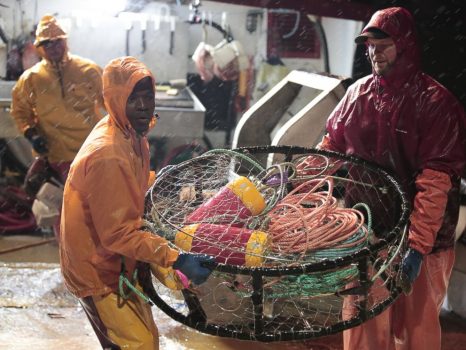
Inside One of the World’s Most Dangerous Jobs
Up to 10 inches wide -– some weighing almost 3 pounds — with 10 legs and of course, claws that can break a finger — Dungeness crab fishing is not for the faint of heart. Add to that the unforgiving weather and potentially tumultuous relationships on board the boats, the situation can become dangerous and deadly at times. No one knows that better than Captain Gary ‘the Ripper’ Ripka and his son Kenny, who own and operate two commercial fishing boats in Newport, Oregon, the Dungeness Crab Capital of the World. “It’s a pretty high-risk job, the most dangerous job in the world,” Gary Ripka told ABC News’ Chief Business, Economics and Technology Correspondent Rebecca Jarvis on a recent episode of Real Biz with Rebecca Jarvis. Video, read the rest here 16:07
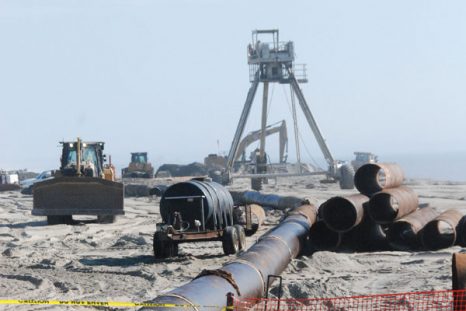
The Manasquan Ridge – Essential Fish Habitat or Common Borrow, and at what cost?
Beach replenishment is costly and exacts a heavy toll on the environment, depleting underwater ridges that are home to a broad variety of sea life. “This project is another important component of the Christie administration’s plan to bring engineered beaches and dunes to the entire coast,” state Department of Environmental Protection Commissioner Bob Martin said September 2, as he announced work would start soon on a new project, pumping another 3.8 million cubic yards of sand from the sea floor onto eight miles of beach from Atlantic City to Longport. Fishermen question the cost to the environment from demands for more and more sand on the beaches. A seafloor survey of sand ridges off Manasquan commissioned in June by the federal Bureau of Ocean Energy Management raised alarms that the Corps of Engineers could dredge more sand from undersea hills that are essential fish habitat. Collectively known as the Manasquan Ridge, the hills attract seasonal concentrations of fish, and could be a future “borrow area,” where sand is extracted to pump onto nearby beaches. “They are already planning to use borrow areas closer to the beach,” said captain James Lovgren of the Fishermen’s Dock Cooperative in Point Pleasant Beach, who, with other fishermen, met with DEP officials in late July regarding their concerns about sand mining. Read the story here 09:16
Fishermen hold Science hostage, demand $45,000 in ransom claim the Feds
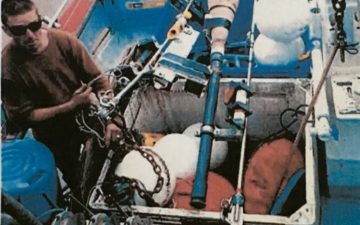 Two fishermen who found a piece of scientific equipment off the coast of Monterey are holding it hostage, interfering with international research, and demanding $45,000 ransom for its return, the federal government claims in court. The United States sued Daniel Sherer, Patrick Anderson and their business, A&S Fisheries, in Federal Court on Friday, accusing them of holding government property “de facto hostage” and causing irreparable harm to an international research project. The “oceanographic mooring buoy,” known as Scientific Mooring MS1, was one of several anchored to the seafloor to record data on the velocity, temperature, salinity and sediment concentration of ocean currents. Read the rest here 08:00
Two fishermen who found a piece of scientific equipment off the coast of Monterey are holding it hostage, interfering with international research, and demanding $45,000 ransom for its return, the federal government claims in court. The United States sued Daniel Sherer, Patrick Anderson and their business, A&S Fisheries, in Federal Court on Friday, accusing them of holding government property “de facto hostage” and causing irreparable harm to an international research project. The “oceanographic mooring buoy,” known as Scientific Mooring MS1, was one of several anchored to the seafloor to record data on the velocity, temperature, salinity and sediment concentration of ocean currents. Read the rest here 08:00
Feature from 1968 on Portuguese fishermen showing Friday Night in New Bedford – Free Admission!
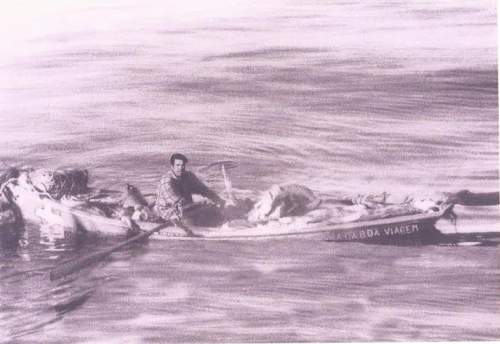 The Dock-U-Mentaries Film Series continues on Friday at 7 p.m. with “The Lonely Dorymen,” a 1968National Geographic program about the Portuguese fishermen who fished for cod on the Grand Banks. Dock-U-Mentaries is a co-production of New Bedford Whaling National Historical Park, the New Bedford Fishing Heritage Center, and the Working Waterfront Festival. Read the rest here! 18:39
The Dock-U-Mentaries Film Series continues on Friday at 7 p.m. with “The Lonely Dorymen,” a 1968National Geographic program about the Portuguese fishermen who fished for cod on the Grand Banks. Dock-U-Mentaries is a co-production of New Bedford Whaling National Historical Park, the New Bedford Fishing Heritage Center, and the Working Waterfront Festival. Read the rest here! 18:39
The real culprit behind the war on watermen is pollution
 The Maryland Department of Natural Resources (DNR) has been accused of waging a “war on watermen,” and watermen are fighting back, seeking changes in the way the bay’s fisheries are being managed. They say their livelihoods are being undermined and their culture threatened. They are right about that, but they are directing their anger at the wrong people. The bay is choking on an overload of nitrogen, phosphorus and sediment from a variety of pollution sources. The results of this over-enrichment are massive population explosions of algae that turn the water to pea soup from spring to fall. This cloudy water blocks sunlight from underwater grasses, reducing this critical habitat for crabs and juvenile fish to only 20 percent of historical coverage. Read the rest here 15:27
The Maryland Department of Natural Resources (DNR) has been accused of waging a “war on watermen,” and watermen are fighting back, seeking changes in the way the bay’s fisheries are being managed. They say their livelihoods are being undermined and their culture threatened. They are right about that, but they are directing their anger at the wrong people. The bay is choking on an overload of nitrogen, phosphorus and sediment from a variety of pollution sources. The results of this over-enrichment are massive population explosions of algae that turn the water to pea soup from spring to fall. This cloudy water blocks sunlight from underwater grasses, reducing this critical habitat for crabs and juvenile fish to only 20 percent of historical coverage. Read the rest here 15:27
Trans-Pacific Partnership – Obama’s ugly show of presidential petulance
 When the going got tough, Barack got in a huff, and then he got gruff. President Obama has worked himself into such a tizzy over the TPP that he’s lashing out at his progressive friends in Congress. He’s mad because they refuse to be stereotypical lemmings, following him over this political cliff called the Trans-Pacific Partnership. It masquerades as a “free trade agreement,” but such savvy and feisty progressive senators as Sherrod Brown, Bernie Sanders and Elizabeth Warren have ripped off the mask, revealing that TPP is not free, not about trade and not anything that the American people would ever agree to. Read the rest here 09:24
When the going got tough, Barack got in a huff, and then he got gruff. President Obama has worked himself into such a tizzy over the TPP that he’s lashing out at his progressive friends in Congress. He’s mad because they refuse to be stereotypical lemmings, following him over this political cliff called the Trans-Pacific Partnership. It masquerades as a “free trade agreement,” but such savvy and feisty progressive senators as Sherrod Brown, Bernie Sanders and Elizabeth Warren have ripped off the mask, revealing that TPP is not free, not about trade and not anything that the American people would ever agree to. Read the rest here 09:24
Lean year for New England cod ahead as shutdown looms
 Catch limits set to take effect this week will take a bite out of an industry that dates back to America’s colonial past: New England cod. But Gulf of Maine cod are what fishermen call a “choke species,” as they must also stop fishing for some other species when the cod fishery shuts down. Haddock, pollock and hake — groundfish that, like cod, dwell on the ocean bottom and share space in with it in markets, restaurants and seafood auctions — will also be harder to come by. Read the rest here 15:09
Catch limits set to take effect this week will take a bite out of an industry that dates back to America’s colonial past: New England cod. But Gulf of Maine cod are what fishermen call a “choke species,” as they must also stop fishing for some other species when the cod fishery shuts down. Haddock, pollock and hake — groundfish that, like cod, dwell on the ocean bottom and share space in with it in markets, restaurants and seafood auctions — will also be harder to come by. Read the rest here 15:09






